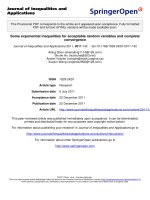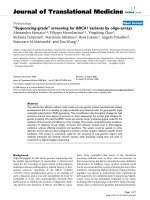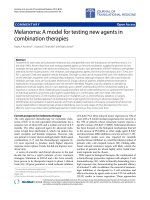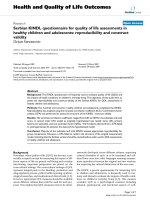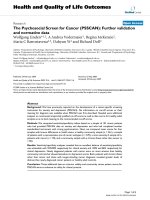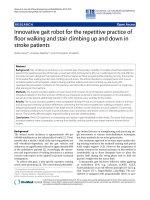Báo cáo hóa học: " Disaster preparedness training for tribal leaders" pot
Bạn đang xem bản rút gọn của tài liệu. Xem và tải ngay bản đầy đủ của tài liệu tại đây (202.85 KB, 5 trang )
BioMed Central
Page 1 of 5
(page number not for citation purposes)
Journal of Occupational Medicine
and Toxicology
Open Access
Short report
Disaster preparedness training for tribal leaders
Wayne F Peate* and Jennie Mullins
Address: Mel and Enid Zuckerman Arizona College of Public Health, University of Arizona, Tucson, Arizona, USA
Email: Wayne F Peate* - ; Jennie Mullins -
* Corresponding author
Abstract
It was with considerable irony that tribal leaders began a collaboration with the University of
Arizona and the Arizona Department of Health Services for training in public health preparedness,
as the tribes had an extended prior history of responding to a host of hazards caused by the
dominant culture. The objective of the training was to ensure that Native American communities
were adequately informed and trained to implement coordinated response plans for a range of
potential public health emergencies on tribal lands and in surrounding communities. This
commentary outlines how cultural competency (including public prayer by an elder during the
training), respect for tribal sovereignity, solicitation of historical examples of indigenous
preparedness, and incorporation of tribal community networks were essential to the success of
this program.
Tribal Public Health Preparedness and Response: Homeland Security Since 1492
Background
A popular tee-shirt in Native-American tribal communi-
ties portrays a photo from the 1880s of Geronimo, the last
tribal leader to lead active armed resistance against the
Federal Government, with the caption "Homeland Secu-
rity Since 1492." It was with considerable irony, therefore,
that tribal leaders began a collaboration with the Univer-
sity of Arizona and the Arizona Department of Health
Services for assistance in training for public health prepar-
edness, as the tribes had an extended prior history of con-
fronting and responding to a host of hazards caused by
the dominant culture.
The approach was to be "all hazard," including: prepara-
tion for fire (Arizona has been devastated by the loss of
800,000 acres from wildland fires in the past three years);
floods from the Colorado River and other bodies of water;
and infectious diseases such as West Nile Virus, Avian
Influenza and other bioterrorism agents [1].
When the discussions led to preparation for these events,
tribal members offered poignant reminders of the public
health consequences of European domination, including:
Biologicals: the loss of entire communities to smallpox
and other infectious agents
Fire: Tribal practice had wisely permitted wildland fires as
part of a natural process. In contrast, federal policy for
years had been zero tolerance for any fire. As a result, thick
underbrush had choked many forests and led to a danger-
ous build up of fire fuels that led to uncontrolled confla-
grations.
Competency based
Cultural competency. Each training session began and
ended with a prayer lead by member of the host tribe. Sep-
aration of religion and state was respected, but so was the
cultural heritage of the participants. "The Whites talk of
Published: 15 January 2008
Journal of Occupational Medicine and Toxicology 2008, 3:2 doi:10.1186/1745-6673-3-2
Received: 18 May 2007
Accepted: 15 January 2008
This article is available from: />© 2008 Peate and Mullins; licensee BioMed Central Ltd.
This is an Open Access article distributed under the terms of the Creative Commons Attribution License ( />),
which permits unrestricted use, distribution, and reproduction in any medium, provided the original work is properly cited.
Journal of Occupational Medicine and Toxicology 2008, 3:2 />Page 2 of 5
(page number not for citation purposes)
mind, body and spirit. For us everything is spiritual from
the time we get up until we go to bed" (personal commu-
nication Annie Kahn, Navajo healer). Prayers focused on
themes such as "protecting the people," the concept of
health as not only physically, but also mental well-being,
and the encouragement of cooperation between all
humanity, no matter their ethnicity.
Objectives
The overall objective of this project was to provide basic
public health emergency and bioterrorism preparedness
and response training for tribal personnel through devel-
oping and delivering three training modules and coordi-
nating implementation statewide by means of five
regional 1 1/2 day sessions in close cooperation with the
Arizona Department of Health Services (ADHS), Office of
Public Health and Emergency Preparedness Response
(OPHEPR) and its Native American Liaison.
The purpose of providing such training was to ensure that
Native American communities were adequately informed,
aware and skilled to implement coordinated response
plans for a range of potential public health emergencies
on tribal lands and in surrounding communities. Training
of tribal public health professionals, emergency manage-
ment personnel and health care system providers, as well
as representatives of tribal community networks, was con-
sidered a priority to strengthen the tribes public health
emergency preparedness infrastructure.
Target audience
The initial target audience was personnel from the 12 Ari-
zona tribes who had contracted with ADHS, OPHEPR to
provide bioterrorism and public health emergency pre-
paredness services to their members. These were: Cocopah
Tribe, Ft. Mohave Indian Tribe, Gila River Indian Com-
munities, Hopi Tribe, Hualapai Tribe, Kaibab-Paiute
Tribe, Navajo Nation, Salt River Pima-Maricopa Indian
Community, San Carlos Apache Tribe, Tohono O'odham
Nation, Tonto Apache Tribe, and White Mountain Apache
Tribe. Training was open to participation by all Arizona
tribes.
Tribes were invited to select other interested personnel to
participate from agencies such as the Bureau of Indian
Affairs or the Indian Health Service. Participating tribes
were also encouraged to include personnel from tribal
health and human service programs, emergency manage-
ment, tribal executive offices, tribal councils, community
leaders and members, and local county bioterrorism coor-
dinators.
Methods
The training session were presented in three modules
approximately four hours in length over the course of one
and one-half consecutive days. Training was delivered
regionally to promote inter-jurisdictional discussion,
learning and network development The five regions were:
(1) Ft. Mohave Indian Tribe and Hualapai Tribe; (2) Gila
River Indian Communities, Salt River Pima-Maricopa
Indian Community, and Tonto Apache Tribe; (3) San Car-
los Apache Tribe and White Mountain Apache Tribe; (4)
Hopi Tribe, Navajo Nation and Kaibab-Paiute Tribe; and
(5) Tohono O'odham Nation and Cocopah Tribe.
The contract specified that training content would build
upon the themes of tribal sovereignty, respecting that each
tribe has a long history of unique and valued language,
culture and traditions, a commitment to community and
family wellness and preparedness, and an understanding
that preparedness is not a new concept for Native Ameri-
cans. Each module incorporated relevant examples of
public health emergencies within the tribal context. These
examples were coordinated with the ADHS Tribal Liaison.
ADHS, OPHEPR collaborated in the process of curriculum
development and training format and assisted in refine-
ment throughout the training sessions. Evaluation tools
were developed jointly and implemented at the partici-
pant level.
The overall goals of the training project were to: (1) pro-
vide opportunities for participants to gain the basic
knowledge, skills and abilities required of all public
health professionals, as defined by the core public health
emergency preparedness competencies published by the
Centers for Disease Control and Prevention and; (2)
understand how these concepts and principles may relate
to the unique needs of tribal communities [2].
Module content
Module 1: Description of the Roles of Public Health
Contents:
• Prevention of epidemics and spread of disease
• Prevention of injuries
• Protection against environmental hazards
• Protection of public through assurance of quality and
accessible health services
• Promotion and encouragement of health behaviors
• Disaster preparedness, response and recovery assistance
• Health codes
Journal of Occupational Medicine and Toxicology 2008, 3:2 />Page 3 of 5
(page number not for citation purposes)
Module 2: Bio-terrorism and How it Relates to Public
Health
Contents:
• Recognizing an emergency
• Disaster versus emergency
• History of bioterrorism
• Bioterrorism and public health
• Agents of bio-terrorism
• Surveillance and disease tracking using technology and
other methods [3]
• Other emergencies (chemical and radiological)
• Psychological response to emergencies
Module 3: Community Emergency Preparedness and
Response
Contents:
• Incident Command System
• Emergency response plans
• Collaboration with County, State and Federal agencies
• Memorandums of understanding
• Mass prophylaxis clinics
• Cultural considerations in the tribal context
An Interagency Service Agreement between the Arizona
Department of Health Services, Office of Public Health
Preparedness and Emergency Response was instituted on
May 1, 2005 with the University of Arizona Mel and Enid
Zuckerman College of Public Health. Between May 1 and
September 30, 2005 all the deliverables of the agreement
were met.
Planning and Assessment
The project team was assembled to implement the scope
of work and included a College of Public instructional
advisor and co-instructor, a MPH instructional specialist
and co-instructor, a MPH- project development and eval-
uation specialist, a project coordinator and administrative
support
Two interagency team meetings occurred in May 2005 to
ensure all parties were clear on the project intent, scope of
work and desired approaches. Input was sought from the
key stakeholders to the project via an emailed survey and
a telephone conference call with the Tribal Bioterrorism
Coordinators. This elicited feedback on key public health
concerns, ideas for case scenarios, delivery preferences
and individuals who wished to be further involved. Bi-
monthly team meetings were held to plan and coordinate
project activities.
Curricula Development
Three distinct four-hour modules were developed follow-
ing the guidelines given for core content areas. Teresa
Wall, MPH, consultant on the project, was the main cur-
riculum specialist with assistance from W.F. Peate, MD,
MPH, project principal investigator. Core competencies
for public health professionals were built into the mod-
ules and learning objectives were developed for each
module. A variety of federal, state and locally developed
materials were drawn upon, adapted and referenced. The
curricula, agenda format and evaluation tools were pre-
sented to the ADHS OPHEPR team on July 6, 2005 for
input. Revisions were made based on that discussion.
Coordination and Implementation
It was important to seek cooperation from the Tribal Bio-
terrorism (BT) Coordinators from the outset of the project
to ensure they were involved in both identifying the par-
ticipants from their tribal organizations and key partners
such as Indian Health Service and local county health
departments for their regional training. Early in the
project a host tribe was identified for each region and
dates were selected. The Project Coordinator then worked
extensively with the host tribe's BT Coordinator to plan
the logistics for the training in that region. This included
choosing an appropriate venue, advertising the trainings,
recruiting participants for partner agencies, working with
the team to identify local representatives to provide a tra-
ditional blessing, participating in the sessions, providing
examples of traditional ways public health had been prac-
ticed in their communities and giving an example of a
public health emergency they had been confronted with
and what strategies had been implemented. Venue costs
were supplemented by the ADHS OPHEPR. Trainings
were delivered according to a total of 122 participants
across all five regions.
Key Accomplishments
This training project was a collaborative effort between
the Arizona Department of Health Services Office of Pub-
lic Health Preparedness and Response, the College of Pub-
lic Health and statewide tribal partners. Relationships
were established quickly between project personnel and
the tribal Bioterrorism Coordinators, particularly those
Journal of Occupational Medicine and Toxicology 2008, 3:2 />Page 4 of 5
(page number not for citation purposes)
identified from the host regional tribe. Each regional
training drew upon the local expertise of the public health
and emergency management systems which allowed them
to be tailored to their unique public health concerns.
Three comprehensive modules were developed and deliv-
ered giving an overview of public health to many diverse
personnel. This was particularly useful for first responders
many of whom had not been exposed to this subject mat-
ter. All participants received an introduction to public
health emergency and bioterrorism preparedness and
response creating a basis for common understanding. The
Native American Liaison for ADHS was actively involved
in developing the approach for the project, curricula and
training design and supported logistics as problems arose.
His participation at each of the regional trainings
strengthened personal relationships and networks and
indicated the importance for collaboration. The curricula
incorporated native concepts of health and traditional
public health practices and presented practical examples
of issues facing tribal communities making it relevant and
responsive to tribal needs.
Challenges
There were several challenges to implementing the train-
ings in the field. These were mostly created by the very
short timeline for the project due to funding restrictions.
This meant there was little time to visit in the field with
key stakeholders and to further encourage participation.
As a result, the identification of the training participants
was left almost entirely to the BT Coordinator for each
tribe. Given the newness of many of these individuals to a
newly created role, not all of these coordinators were well
integrated into their local public health system. Some
were not based within their health programs, but rather
operated out of their emergency management depart-
ments. As a result several trainings had limited public
health personnel participation.
Additionally the scope of the project was very broad as it
encompassed all five regions within the state, and
required cooperation between tribal, county and federal
agency counterparts. Fragmentation within each local
public health system resulted in some communication
breakdowns and last minute requests.
Other challenges to participation in the training included
limited resources available to the tribes. In some cases
there were no travel funds for relevant personnel to attend
the training session. In other instances, public health
emergency preparedness and issues of bioterrorism were
not considered priorities particularly compared other
competing needs facing under-funded tribal health pro-
grams. Subsequently, there were several of the tribes
whose BT coordinators and public health personnel were
not represented at the training.
In regards to the curriculum, a "one-size fits all" approach
created some challenges to meeting the needs of the audi-
ence. Due to the diverse backgrounds, roles and skills sets
of the participants it was difficult to find the right pitch for
all. For some it was too basic and for others too advanced.
The content areas required for each module were very
broad and it was difficult to present all the content com-
fortably in three half-day sessions.
Evaluation Summary
The overall quality of the training series was evaluated
highly. Of the 80 respondents across all five regional
trainings, a 66% survey response rate, the average rating
regarding overall satisfaction with the quality of the train-
ings was 4.2 out of 5, placing the average between the sat-
isfied to very satisfied categories.
The most salient topics participants reported as a result of
the training were :
• The importance of tribal and nontribal interdepartmen-
tal communication and collaboration
• The need for all personnel to understand the incident
command system (ICS)
• The importance of emergency planning and preparation
and a cohesive mutually understood approach
• The need to be vigilant
• The need to incorporate cultural and other public health
competencies into emergency preparedness plans
• Better understanding of tribal infrastructure
• Need for collaboration with county, state and federal
partners
• Practical information about how tribal community pub-
lic health preparedness response is organized and who to
call upon for assistance
• The need to include public health to a greater degree in
emergency planning and response.
Recommendations for Refinement
Refinements of the trainings came from evaluation data as
well as from the project team. Key recommendations from
participants included making the sessions longer with
more interactive group scenarios. Others thought the
training could be condensed into a one-day training with
less emphasis on the history and mission of public health.
Many requested more training of a similar nature to be
Publish with BioMed Central and every
scientist can read your work free of charge
"BioMed Central will be the most significant development for
disseminating the results of biomedical research in our lifetime."
Sir Paul Nurse, Cancer Research UK
Your research papers will be:
available free of charge to the entire biomedical community
peer reviewed and published immediately upon acceptance
cited in PubMed and archived on PubMed Central
yours — you keep the copyright
Submit your manuscript here:
/>BioMedcentral
Journal of Occupational Medicine and Toxicology 2008, 3:2 />Page 5 of 5
(page number not for citation purposes)
held within their local setting with further encouragement
of tribal leaders to attend.
The project team suggests that an introduction to public
health could be useful on its own to tribal personnel and
leaders who have limited exposure to the role of public
health.
Training would most likely have drawn greater participa-
tion if conducted in the individual tribal communities
with support from leadership and could have been tai-
lored further to their unique concerns and stage of emer-
gency preparedness.
Future training needs
• Develop advanced modules with practical scenarios/
exercises including surveillance and incorporate more
simulated ICS scenarios and drills in the tribal context.
• Assist BT Coordinators in identifying their key public
health partners and local assets and building their collab-
orative leadership skills
• Continue to draw upon local experts and shared experi-
ences
• In addition to individualized sessions for each tribe,
offer two regional trainings annually to encourage inter-
tribal/agency exchange on public health emergency plan-
ning and preparedness.
Conclusion
This was a highly successful collaboration between ADHS,
the College of Public Health and the statewide tribal part-
ners. Trainings were well received and highly rated in
terms of quality and usefulness. Three distinct training
curricula along with products and tools have been devel-
oped and adapted for the Arizona tribal context. Sustain-
ability of these trainings in local tribal settings has been
requested by many tribal participants. Additional training
needs were identified for the tribes. The statewide tribal
public health emergency preparedness network was
strengthened as a result of this project.
Acknowledgements
Grateful acknowledgement is made to Michael Allison, Tribal Liason, Ari-
zona Department of Health Services, for his leadership in developing this
project.
Funding for this project was made available through an Inter-agency Service
Agreement Arizona Department of Health Services and University of Ari-
zona
Mel and Enid Zuckerman College of Public Health
References
1. [ accessed May 21,
2006
2. Roubideaux Y: Perspectives on American Indian Health. Am J
Public Health 2002, 92:1401-1403.
3. Sequist TD, Cullen T, Ayanian JZ: Information Technology as a
Tool to Improve the Quality of American Indian Health
Care. Am J Public Health 2005, 95:2173-2179.
